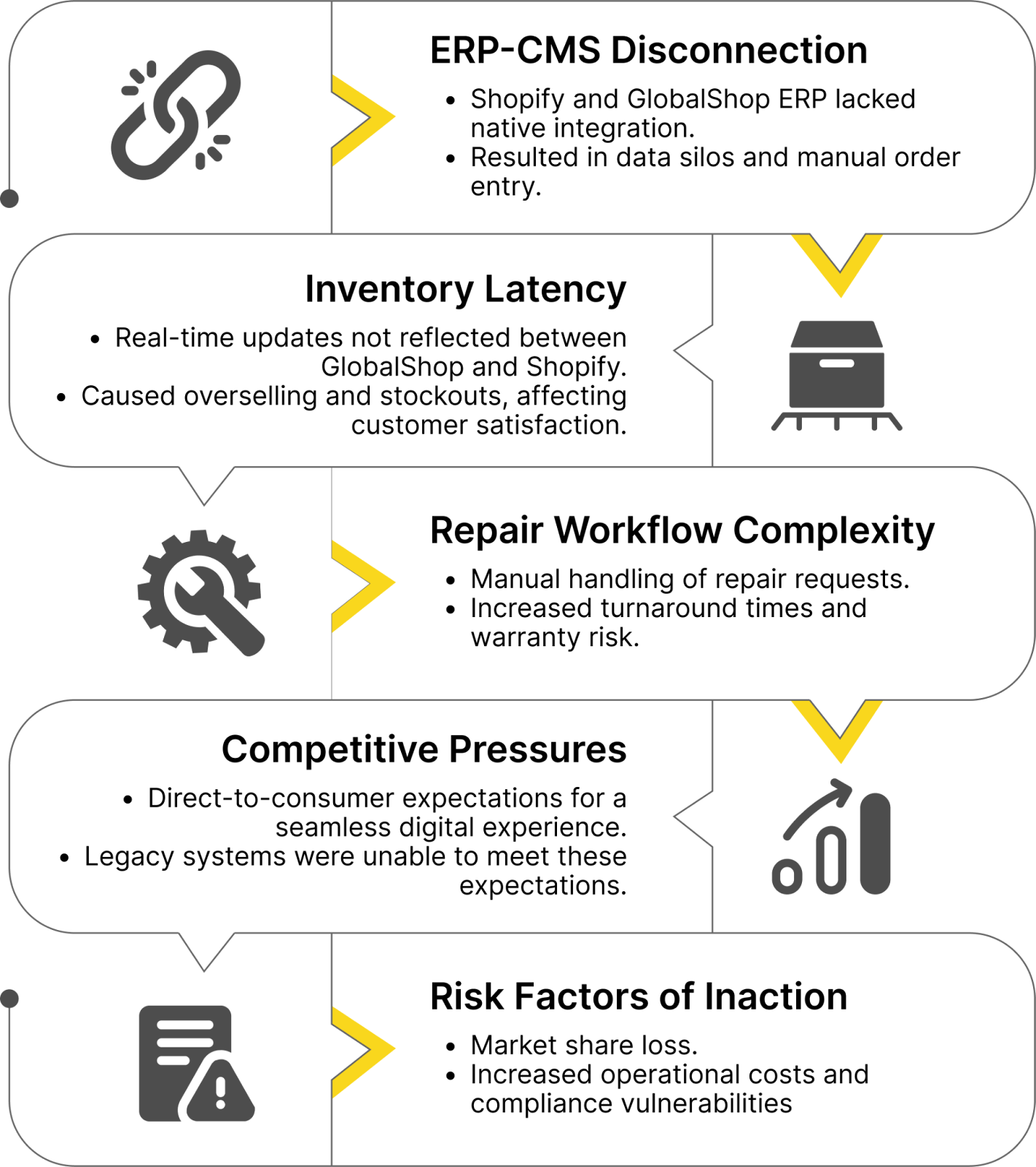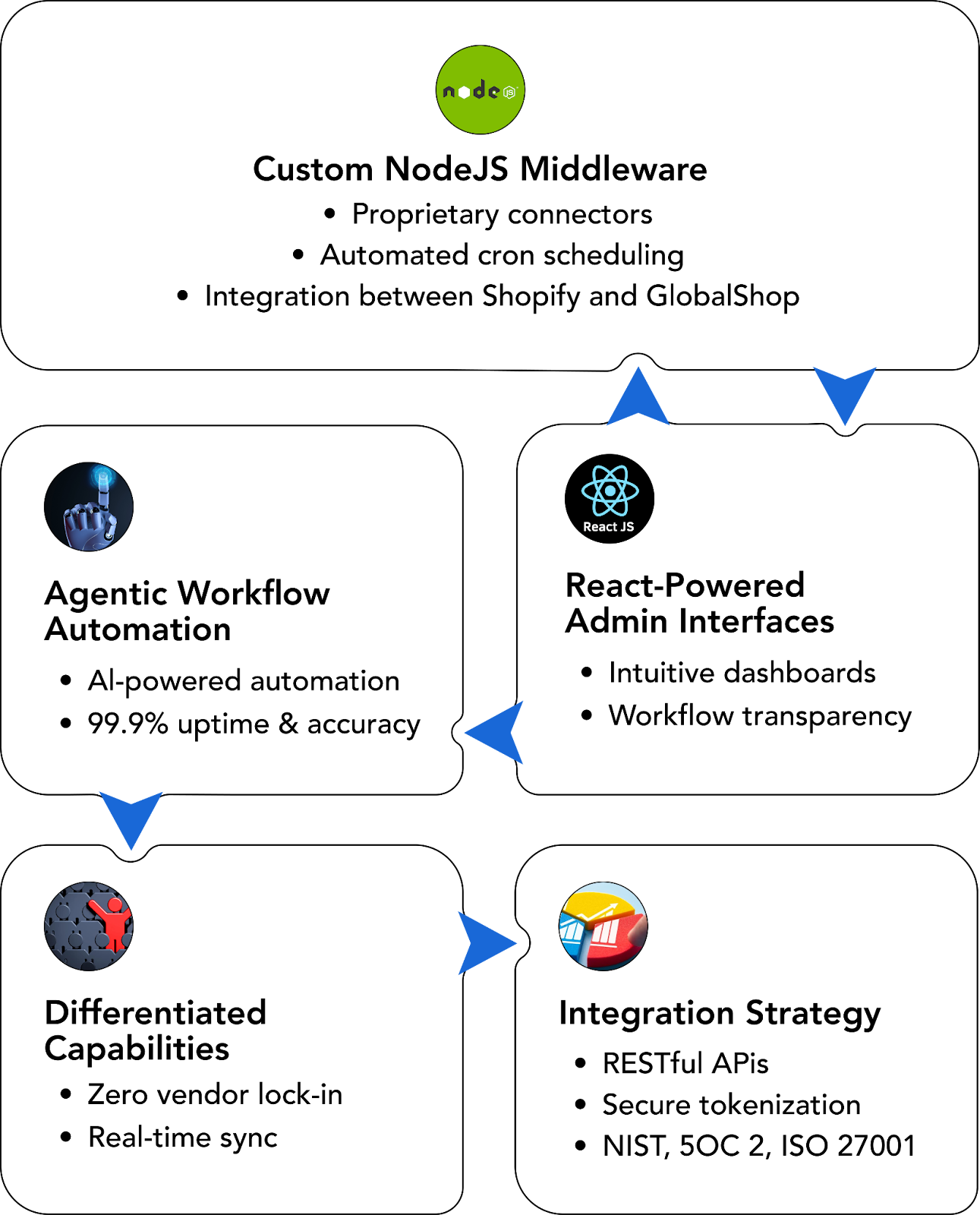Enterprise AI Implementation: Paul C. Buff’s Shopify–ERP Integration & Workflow Automation Case Study by MLVeda
Paul C. Buff

Enterprise AI Implementation: Paul C. Buff’s Shopify–ERP Integration & Workflow Automation Case Study by MLVeda
Introduction
Driving 90% Faster Order Processing and Enhanced Customer Experience with AI-Powered Integration
Paul C. Buff, a global leader in studio lighting solutions, undertook an ambitious digital transformation aimed at eliminating operational bottlenecks, enhancing customer experience, and driving competitive advantage. Facing core system silos and legacy limitations, they partnered with MLVeda to architect and implement a seamless Shopify-to-ERP integration powered by agentic AI workflow automation, and enterprise-grade middleware orchestration.
Solution Scope & Quantifiable Impact:
- Real-time data synchronization across commerce and ERP workflows
- Dramatic reduction in manual order and inventory processing times
- Significant improvement in customer satisfaction and business agility
- Future-proofed infrastructure to enable AI-powered feature innovation





Business Challenges
Complex Operational Constraints and Market Pressures

As a Fortune-ranked enterprise, Paul C. Buff faced critical challenges impacting operational efficiency and customer experience:
- ERP-CMS Disconnection: Shopify lacked native integration with GlobalShop ERP, generating data silos and manual reconciliation causing hours-long delays.
- Inventory Latency: Inventory updates in GlobalShop were delayed in Shopify, resulting in overselling risks and stockouts.
- Repair Workflow Complexity: Manual repair request handling increased turnaround times and warranty-related risks.
- Digital Experience Expectations: Direct-to-consumer demands for seamless and instant interactions outpaced the capabilities of legacy workflows.
- Risk of Inaction: Market share decline, escalating operational costs, and potential compliance violations risked business continuity.
According to Gartner (2024), enterprises leveraging end-to-end AI systems achieve up to 45% faster order-to-cash cycles, reduce manual interventions by 30%, and improve customer NPS scores by 20%.
Solution Architecture
Agentic AI Middleware Orchestration for Secure, Scalable Integration

MLVeda engineered a future-ready, modular solution emphasizing interoperability, reliability, and compliance:
- Custom NodeJS Middleware: Proprietary connectors provided real-time, bidirectional syncing between Shopify and GlobalShop, overcoming lack of native webhooks with intelligent cron scheduling.
- Agentic Workflow Automation: AI-powered automation embedded at every integration point ensured 99.9% uptime, transactional accuracy, and predictive anomaly detection.
- Executive-Grade React Admin Interfaces: Delivered transparent ERP data controls and dashboards within Shopify to enhance operational governance.
- Robust Security & Compliance: Employed RESTful APIs with secure tokenization, role-based access controls, and aligned architecture to strict NIST, SOC 2, and ISO 27001 mandates.
Differentiators:
- Zero vendor lock-in with composable architecture ready for future ERP/e-commerce platforms
- Sub-minute data propagation versus batch-sync competitors
Embedded AI workflows supporting advanced analytics and anomaly detection abilities
Key Technical Components
Core Systems & Business Functions
Integration Architecture:
- Data flow is orchestrated via secure API endpoints, middleware acts as a real-time bridge translating data models and enforcing business logic.
- All modules adhere to a common governance framework, allowing role-based access, audit logging, and compliance with enterprise standards.
Implementation Methodology
Quantified Business Results
Industry Benchmarked Impact Metrics
Industry research (BCG & Gartner, 2024) reports integrated agentic AI platforms deliver median ROI of 220% within first year, accelerating digital transformation by 15–20%.
Strategic Best Practices & Executive Takeaways

- Executive Sponsorship is Vital: Active C-suite involvement drives adoption and project success.
- Strong Data Governance: Ensuring compliance with NIST, SOC 2, and ISO 27001 enables audit readiness and risk mitigation.
- Phased and Risk-Mitigated Delivery: Incremental rollout reduces disruption and accelerates time to value.
- Custom Integration Outperforms Plug-and-Play: Proprietary middleware enables agility and scalability.
- Continuous Optimization is Essential: Regular performance reviews and AI upgrades sustain ROI.
Enterprise Technology Leaders Should:
- Benchmark against peer enterprises and analyst data for vendor selection.
- Ensure security and extensibility compliance upfront.
- Assess vendor adaptability: Vendor agility to build proprietary connectors and custom automation is a critical differentiator.
- Invest in stakeholder enablement: Training, documentation, and executive dashboards accelerate adoption.
Strategic Conclusion
Paul C. Buff’s strategic partnership with MLVeda demonstrates the transformative power of enterprise AI systems coupled with intelligent workflow automation. This digital transformation:
- Delivered a secure, scalable omnichannel commerce-to-ERP integration.
- Realized quantifiable efficiency, operational, and customer experience gains.
- Established an AI-ready, compliant platform aligned to industry governance frameworks.
- Accelerated ROI realization and fortified competitive positioning for future innovation.
Broader Enterprise AI Implications
This case affirms that partnering with an authority like MLVeda unlocks not just operational efficiency but the agility and technical foundation required to lead in digitally disrupted markets. For C-suite executives targeting transformation—MLVeda’s solution delivers measurable impact, mitigates risk, and sets the stage for sustainable enterprise innovation.
Evaluate your AI and workflow modernization strategy with MLVeda’s proven expertise to future-proof your technology landscape and accelerate enterprise innovation.
We’re Listening
We’d love to hear from you, whether you have a partnership inquiry or just want to discuss ways to improve your online store.
Please reach out to our team at services@mlveda.com for general questions, or simply fill in the form to start the conversation. We're here to help bring your ecommerce vision to life.


